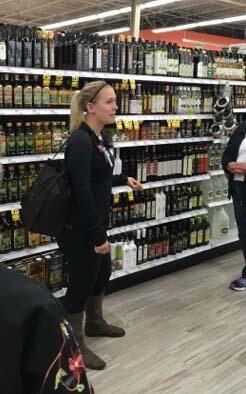Posted on October 21, 2016
Grocery store tours: An expert’s guide to trimming costs, calories from your cart
 With tens of thousands of food products available in most grocery stores, it’s good to have a grocery shopping game plan before you hit the aisles. A grocery store tour with a nutrition expert is one way to learn how to fill your cart with balanced meals and healthy snacks.
With tens of thousands of food products available in most grocery stores, it’s good to have a grocery shopping game plan before you hit the aisles. A grocery store tour with a nutrition expert is one way to learn how to fill your cart with balanced meals and healthy snacks.
Jessi Boehme (pictured below), a Registered Dietitian Nutritionist at Mary Free Bed, has led numerous grocery store tours for people of all ages seeking to improve their health. Below are some of her favorite shopping secrets:
- Always bring your list and PLAN AHEAD! It cannot be emphasized enough: One of the best ways to start meal planning is to go through your fridge and freezer and see what you’ve already got on hand.
- Shop the perimeter. During grocery tours, we rarely venture into any of the center aisles. Why? If you stick to the outside, you’re not going to pass by as many tempting foods.
- Check your local store for local produce! Sometimes, it’s less expensive and it tastes fresher because it hasn’t traveled as far.
- Read your unit prices. Unit price is the price per ounce or price per pound found on the shelf tag. Example: Say a big bag of dried apricots costs $12, but per ounce, is 31 cents. The same apricots in a smaller bag cost much less at $4.50, but cost $1.70 per ounce. Sometimes paying more up front means you’re paying less per ounce for the same product.
 Buying the whole product may result in the same type of savings. A whole chicken can be purchased for generally $1.09 per pound versus a package of chicken thighs for $4.59 per pound. You do need to weigh your pros and cons of buying the pieces or the whole thing, but it can be another way to get creative and safe money too.
Buying the whole product may result in the same type of savings. A whole chicken can be purchased for generally $1.09 per pound versus a package of chicken thighs for $4.59 per pound. You do need to weigh your pros and cons of buying the pieces or the whole thing, but it can be another way to get creative and safe money too.
- Buying whole blocks of cheese saves you from eating the extra starch, which is added to shredded bagged cheese to keep it separated. You also can buy it when it goes on sale and put the entire block into the freezer right in its wrapper.
- The wall of yogurt can be overwhelming. Your best bet? Buy the large plain (or vanilla) tubs and add your own toppings, like granola, fruit (canned or fresh), a little powdered peanut butter or a little maple extract. It’s cheaper in the long run and you’ll get a fresher taste without all of the added sugars.
- When shopping for ingredients like spices, canned goods and oils, be certain to compare the price of brand names versus store brands. Then, compare your nutrition labels. If you’re only seeing differences in price, the store brand is your best bet.
- Companies compete to have their items in the most attractive and easily-found spot in the aisle. This means they’re the first brands you see and they’re usually at eye level. Always look at the top and bottom shelf to find the same or similar items at a lower cost.
- Avoid aisles you absolutely don’t have to visit. When you make your grocery list, make one list for all of the foods/goods you “need” then make a separate list of your “wants.” After you finish shopping for all of your needs you may be less likely to go back and find all of your “wants.”
Looking for more customized nutritional guidance? Check out a free informational session offered by Mary Free Bed’s Weight Management Program and let us help you set and reach your healthy lifestyle goals.
We also offer Outpatient Nutrition Services, which include one-on-one sessions with experts who can help you to meet your wellness goals.





